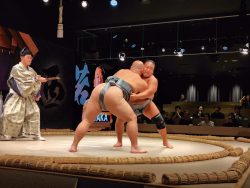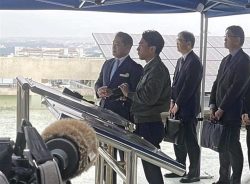
Kenji Komatsu makes baumkuchen at Welcome Ninoshima on Ninoshima island in Hiroshima. Inset: Baumkuchen baked at Welcome Ninoshima
11:00 JST, July 24, 2022
HIROSHIMA — Baumkuchen, a baked confection born in Germany, was first made in Japan just after World War I (1914-1918) on a small island in the Seto Inland Sea.
Ninoshima island in Hiroshima Bay, which is now part of Hiroshima City, is the first place in Japan where the Western sweet famous for its tree-ring cross section is known to have been made. At the time, there was a prisoner-of-war camp on the island, and records say that a German prisoner served baumkuchen to his fellow prisoners.
On the tiny island, there was not only a POW camp, but also a quarantine station for the Imperial Japanese Army. When the atomic bomb was dropped on Hiroshima on Aug. 6, 1945, the quarantine station was converted into a hospital to treat bombing victims. It is said that about 10,000 injured people were sent to the hospital on Ninoshima island over a 20-day period.
The island, where you can find remnants of the war here and there, is passing these memories on to the next generation, while trying to promote itself as the Japanese home of the iconic cake.
Island of baumkuchen
Right in front of Ninoshima Port, visitors can find a baumkuchen-making workshop at the tourist information center Welcome Ninoshima, and can experience firsthand how baumkuchen is created for \3,000.
The method of making the confection is the same as it was 100 years ago. Participants are shown how to apply the dough — a mixture of egg, flour, butter and sugar — around a wooden rod and bake the surface over a gas flame to make a thin layer of cake. The process is repeated to create many layers.
After about 90 minutes, the baumkuchen had grown to about 10 centimeters in diameter and 20 centimeters in length. Its appearance well represented the literal translation of its German name: tree cake.
“I hope visitors will learn about how baumkuchen was started on the island and about the island itself through the workshops,” said Kenji Komatsu, 45, who operates the information center.

Baumkuchen baked at Welcome Ninoshima
Business founded by ex-POW
Ninoshima island was once home to the nation’s largest quarantine station, and part of the island was used as a POW camp during World War I. About 550 prisoners were detained there, including confectioner Karl Juchheim (1886-1945).

Karl Juchheim
Juchheim ran a coffee shop in Qingdao, China, when the city was a German-leased territory. He was captured by the Japanese military and sent to the camp.
“People detained in the POW camp were allowed to live relatively freely,” said Kazuo Miyazaki, 74, volunteer guide on the island. “They enjoyed soccer and music, and Juchheim began to bake baumkuchen for the other detainees.”
In 1919, his baumkuchen was presented at an exhibition held at the Hiroshima Prefectural Commercial Exhibition Hall — the present-day Atomic Bomb Dome — to feature various products made by German POWs. The cake was very popular among the locals.
Becoming confident of his capabilities, Juchheim decided to stay and work in Japan. After being set free in 1920, he opened a confectionery store in Yokohama in 1922.
After the store was destroyed in the Great Kanto Earthquake in 1923, he moved to Kobe, where he had an acquaintance, and opened a new store. His baumkuchen became so popular that Western confectionery stores in the neighboring area started selling his product.
After his death, his store fell into financial difficulties. But his wife, Elise, and apprentices later rebuilt the business. This was the beginning of Juchheim Co., based in Kobe, which operates 264 confectionery stores nationwide today.
Promotion of ‘first place’
Although baumkuchen has become a favorite sweet for many Japanese people, Ninoshima island has remained rather obscure. Aside from so many not knowing about the island’s baumkuchen legacy, the history of Ninoshima’s POW camp has faded along with other memories of war.
The island’s population started to decline after peaking at 2,953 at the end of March 1966. At the end of March 2021, it stood at only 736.
The baumkuchen workshop was Komatsu’s idea as one of the initiatives to revitalize the island. Komatsu moved to the island in 2018 on a government program to help revitalize rural communities. The program’s term was three years, but after completing his term, he continues to live on the island, being active in planning kayaking tours and other events.
The local authority and confectionery stores have established a council to promote the island as the first place in Japan where baumkuchen was made.
At an event held by the council in 2019 to commemorate the 100th anniversary of the German POW’s exhibition, a 20.87-meter-long baumkuchen was baked, which was certified by Guinness World Records as the “world’s longest baumkuchen.”
After World War II, Ninoshima became an island for peace education. The Ninoshima Seaside Children’s Nature Center was established along with other facilities, receiving students on school excursions.
Local volunteer guides conduct tours of war-related ruins and other sites on the island.
“I hope that the next generation will learn about the history of Ninoshima and use the knowledge to maintain peace in the future,” Miyazaki said.
Extend your trip!
Ninoshima Peace Museum

Ninoshima Peace Museum
The museum was opened in April 2021. It depicts the history of Ninoshima since the Sino-Japanese War (1894-95) through photos documenting the lives of German POWs, with Karl Juchheim among them, and other materials.
There is also an exhibit that describes the time of the atomic bombing. Some exhibits explain little-known facts — for example, victims of the atomic bombing were buried in the ground without being appropriately cremated, and many human remains were found later — along with displaying personal belongings of victims such as toothbrushes and belt buckles.
How to get there

Ninoshima island is about 3 kilometers from Hiroshima Port and is accessible by a 20-minute ferry ride from Hiroshima Port Ujina Passenger Terminal. The terminal is about 30-50 minutes from JR Hiroshima Station by bus or the Hiroshima Electric Railway train. The island is about 13 kilometers in circumference. Visitors can use rental bicycles or walk around the island.
Related Tags
"Features" POPULAR ARTICLE
-

Students Recreate 19th-Century Bento Boxes Made for Ino Tadataka’s Survey Team in Hot Spring Town on Nakasendo Road
-

Santa Claus Delivers Christmas Presents to Penguins at Aquarium in Japan’s Nagasaki Prefecture
-

Sumo Restaurant in Tokyo Teaches Foreign Visitors About the Ancient Sport, with Bouts Between Retired Rikishi
-

Autonomous Passenger Ship Connects Mainland with Remote Island in Seto Inland Sea; World’s 1st Commercially Operated Autonomous Vessel
-

Osaka’s Sumiyoshi Taisha Shrine Bustles with New Year’s Visitors
JN ACCESS RANKING
-

As Chinese Tourists Shun Japan, Hotels and Stores Suffer
-

Tokyo Economic Security Forum to Hold Inaugural Meeting Amid Tense Global Environment
-

Osaka-Kansai Expo’s Economic Impact Estimated at ¥3.6 Trillion, Takes Actual Visitor Numbers into Account
-

BOJ Gov. Ueda: Highly Likely Mechanism for Rising Wages, Prices Will Be Maintained
-

Japan Govt Adopts Measures to Curb Mega Solar Power Plant Projects Amid Environmental Concerns


























